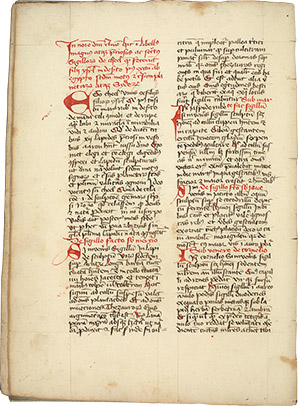Among the scientific writings of Late Antiquity and the Middle Ages are treatises known as Lapidaries, short encyclopedic works on the properties of stones and minerals. One type of lapidary, exemplified by Marbode of Rennes's famous Latin work On Stones, listed the name of each stone (often alphabetically), followed by details such as their color, where they are found, and any special "virtues" or powers that the stone possesses (such as the loadstone's power of attraction or the bezoar's reputation as an antidote for poison). Another type of lapidary was concerned with the symbolic meaning of the twelve biblical stones of the high priest's breastplate and the heavenly Jerusalem.
The Techel/Azareus Complex, pictured here, is a Latin lapidary in which engravings of astrological symbols are said to imbue the stones with powers. The prologue (in red) offers an origin story for the text and the stones it describes: "In the name of the Lord, Amen. This is Cheel's great, precious, and secret little book of the sigils that the children of Israel made in the desert after their departure from Egypt, in accordance with the motion and course of the planets and constellations." Entries for the stones begin with the phrase "If you find..." and then describe in detail the images, based largely on Greco-Roman astrological iconography, that one might find engraved on a stone. The reader is then instructed on the special virtues and magical uses of any stone that meets the description.
The origins of the Techel/Azareus Complex remain a mystery, but the text has roots and parallels in the Greek and Arabic lapidary traditions. The oldest identified copy of this Latin lapidary dates to the twelfth century. In the course of the next few centuries, it was translated into several vernacular languages and became one of the most widely circulated and cited of all medieval lapidaries. Notably, the text was also translated into Hebrew (via Anglo-Norman) in the thirteenth century. By the end of the Middle Ages, two more Jewish versions had appeared: one written in Italian in Hebrew characters and a second Hebrew version (via Castilian and Catalan) that may have originated outside the Latin tradition. The lapidary in all its versions is part of a wider movement in the Middle Ages to transmit and translate scientific works, bridging not only ancient and medieval traditions but also cultural, linguistic, and religious ones.
